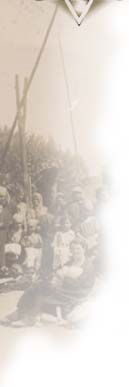|
|
||||||||||||
|
|
The History of the Jewish Community in Rusnė (Russ)
The first Jews, traders in wood, settled down not in Šilokarčema (Šilutė, Heydekrug), but in Rusnė, the largest settlement in the area of Šilokarčema until the very end of the 19th century. Rusnė had the largest population of Jews, in comparison to the other settlements of the area. With the start of ferrying rafts on the Nemunas River, the Jews found favourable conditions for developing their businesses in this settlement.
The first Jew of Rusnė mentioned in 1789 was Isaac Laser, otherwise called as Laser Cohn, who was an inn-keeper and an intermediate between Russian and Jewish timber traders. In 1855, 33 Jews were the residents of the settlement, whereas in 1880 their number reached 133.
The Jewish community stopped growing in Rusnė after World War I. The importance of the township was going down as well at that time. The number of residents there dropped from 3 to 1.5 thousand. This fact had been predetermined by the discontinuation of ferrying rafts on the Nemunas River from Poland due to the conflict between Lithuania and Poland. Four sawmills and two timber forwarding firms cancelled their activities in Rusnė. The growth of Šilokarčema into an administrative centre of the area added to the floundering of Rusnė. Šilokarčema, with its developing industry and culture, was attracting for a large investment, therefore there was a natural drift of population, including Jews and their capital, from the surrounding area, including Rusnė, to this centre. Supposedly, there were 17 Jewish families residing in Rusnė in1920.
The Jews of Rusnė were involved in timber business; there were owners of trade firms and hotels, as well as small tradesmen and craftsmen among them. The Jews mentioned in the records for the year 1922 were tradesmen in textile articles and chandlery, a baker, a shoemaker, a metalworker, etc.
The Jews started leaving the Klaipėda (Memel) region on a mass scale at the beginning of 1939, when the majority of seats at the election to the Regional Directorate were won by the National Socialist party. The Jews from the Klaipėda region were moving to such towns of Samogitia in Lithuania as Palanga, Kretinga, Jurbarkas and Tauragė, and to Kaunas as well.
The destiny of the Rusnė Jews in the Second World War is unknown. It is supposed that part of them were killed in the massacres held in Gargždai, Kretinga, Palanga, Švėkšna, Tauragė, Jurbarkas and other places in the summer of 1941. Part of them could have been placed at the Šiauliai or Kaunas ghettos that were liquidated in the summer of 1944. The majority of Jewish women were taken to the Stuthof and men to the Dachau concentration camps.
Very little information has been left on the religious life of Jews in Rusnė. The synagogue and the ritual Jewish bathing place were built in 1857. The Jews of Rusnė established their own community of the Rusnė synagogue on 1 January, 1863, after the permission from the Šilokarčema synagogue had been received.
It is supposed that the first Jewish cemetery in the area had to be started in Rusnė. The Jewish community purchased a land plot for that purpose near Pakalnė River in 1837. Unfortunately, due to the low and regularly flooded location, it was impossible to use this cemetery. Thus, the Jews of Rusnė were buried in the Žibai (Szibben) Jewish cemetery started in 1844. In the period from 1869 to 1870, the Jewish communities of Rusnė and Šilokarčema purchased a new land plot for the cemetery in Barzdūnai (Barsduhnen), which later became the only cemetery in the whole area. The synagogue of Rusnė, just like the Jewish cemetery in Šilokarčema, was destroyed in the Second World War.
As for
today, the cultural and architectural heritage of the Rusnė Jews has been derelict and it has
not been investigated. |
|||||||||||
|
|
|
|||||||||||

